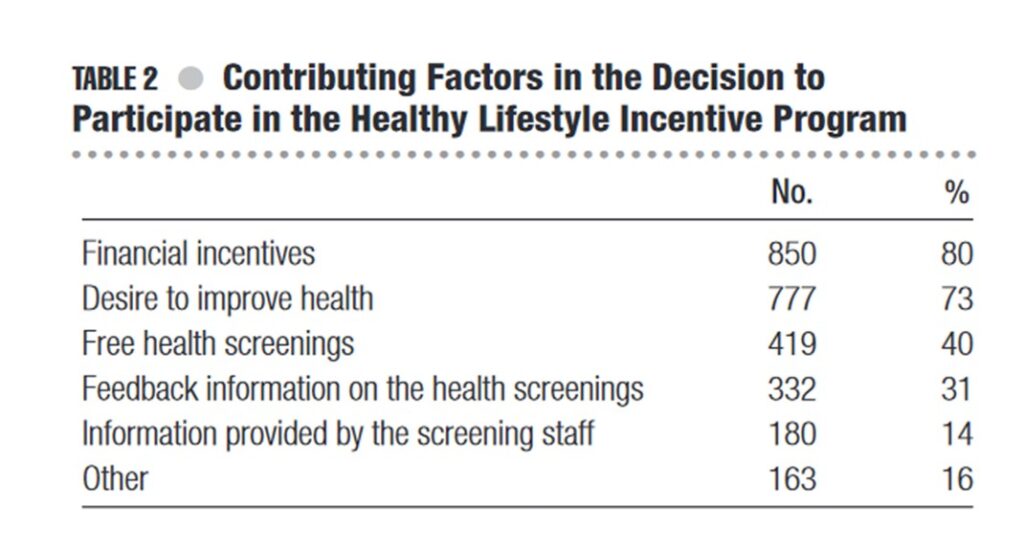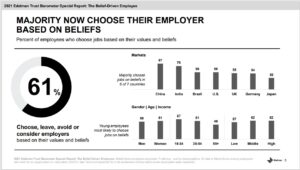5 proven incentive ideas to engage employees and improve wellness ROI
From recognition to PTO to hard cash, experts and organizations share their fitness-initiative success stories.

The U.S. workforce is re-emerging from home offices. Worksite gyms are opening back up. So it’s time to start rolling out those get-back-your-health fitness programs.
But how do you get employees engaged with wellness programs? Evidence indicates incentives increase participation and positively impact health outcomes. While there are many incentives to choose from, some are better at getting employees engaged and accomplishing their desired wellness goals. They include:
- Recognition
- Prizes
- PTO
- Benefit contribution discounts
- Cash

SOURCE: Wolters Kluwer Health|Lippincott Williams & Wilkins
Everyone loves a trophy
Recognition and winning are motivating factors for many people, especially if your organization’s culture is on the competitive side. “We have found that recognition can be as powerful, if not more powerful, than a dollar reward,” says Nicholas Layne, director of strategic operations for Propel, a health-and-wellness tech company. “This recognition can happen at a peer-to-peer level as well as an organizational level.”

Group programs often produce better participation than one-on-one coaching. Teams, social interaction, and public leaderboards all contribute to an environment where naming a winner has serious value. Recognition can look different based on company culture or even employee feedback. Posting personal “wins” on social media is one way to recognize employees from a peer-to-peer standpoint. However, recognition has even more impact at the organizational level. “Imagine the level of employee engagement one of our clients received when they launched a physical-activity competition with the winning prize of a ride in the company’s world-famous blimp—not to mention recognition among top executives,” Layne says.
Prizes, big and small
It may seem obvious since they are statistically at the top of the list for most-used incentives, but employees love prizes. “It’s how we’re programmed: people like to win,” says Rachel Sapoznik, founder of a Florida-based corporate insurance provider that focuses on wellness. “It’s a double win, taking care of yourself and winning a prize.”

Finding the right match for the initiative, the prospective employee participants, and the organization’s budget may mean getting creative. Sapoznik says that depending on budget, it could be anything from a bike to an exercise mirror.
Offering small prizes at levels along the program’s run can also keep individuals engaged, such as gift cards or athletic gear. Sapoznik recommends using employee surveys to gauge which prizes have more interest before investing in a specific direction. Also, considering cultural and generational factors is crucial if organizations want to reach the whole employee population.
Paid Time Off
Giving employees more of an already-valued employee benefit has proven effective at increasing engagement by 30% at some organizations. Offering ways to earn more paid time off is a proven incentive for long-term engagement with a wellness program.
A Deloitte study found 77% of professionals have experienced burnout at their current job, and one-third of them didn’t feel comfortable taking time off. So, encouraging employees to use their PTO suits a company culture that prioritizes mental health. There are several ways to add PTO. One company that earned the Koop Award for its wellness program allowed employees to earn points toward up to 12 hours of PTO. Others gave an entire day as a reward for reaching wellness milestones.
Discounting or subsidizing benefits contributions
Like PTO, offering discounts on employee contributions puts more money in workers’ pockets, and that’s an incentive that’s gaining popularity as health costs rise nationally. But, while it’s a more expensive incentive, it will earn returns when claims costs go down if it encourages more employees to engage with a wellness program initiative. For example, when Mervat Elschwarby was the vice president of human resources at the Swiss office-supply company Esselte’s North American division, she managed weight loss and smoking cessation programs for its 5,000 employees.
“We gave employees a $200 credit to be used toward wellness or out-of-pocket medical expenses,” Elshwarby says. “The only requirement was that they had to enroll in and complete either smoking cessation or weight-loss programs. They did not have to quit smoking or lose weight. That took some of the pressure off and allowed them to have more control in their success.”

The company was self-insured, so it was a worthwhile investment, Elschwarby says. During the renewal period, Esselte discovered its insurance-premium increase was half the national average. “It was successful financially and demonstrated our commitment to maintaining a healthy workforce,” she says.
Cash is motivating
A Journal of Public Health Management Practice study found financial incentives were the primary factor for employees to participate in wellness initiatives, followed by a desire to be healthier. The study found that participation increased seven points among men and nine points among women over the five-year study period.
At Coffee Affection, an online all-things-coffee retail site, managers wanted a way to encourage employees to get fit without demoralizing weigh-ins. The wellness team chose a mile-improvement challenge, so anyone on the fitness scale could compete for a chance to win a $500 Visa gift card. Employees had two months to shave the most time off their mile run.
“Not everyone in the office participated, but those that did definitely enjoyed the camaraderie and getting physically fit,” says CMO Kate MacDonnell. “Going forward, we’re thinking about making this an annual initiative.”

MacDonnell said the incentive worked well because employees who typically wouldn’t have participated in the program were interested. “This was our first initiative, and we were very happy with the results,” she says. “Almost everyone who participated gave feedback, and it was all positive.”
COMMENT
Ragan.com Daily Headlines
RECOMMENDED READING
6 questions with: Stephanie Wilson of Wicked Creative
Wellness trends to watch in 2023
How to craft a wellness plan from A to Z
Tags: Fitness, incentive, initiative, programs, Wellness






